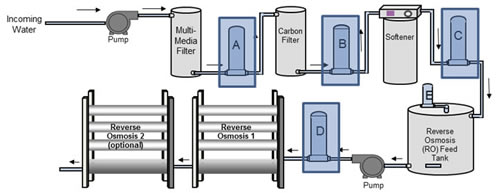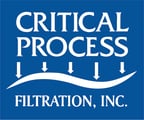Water treatment systems in medical environments range from simple filters for wash water to dialysis water systems that require FDA approval as medical devices.
All of these systems use filters to remove sediment and large particles 1 micron or larger to protect downstream processes.
Any water coming into any facility will contain particulate matter. Whether from a municipal system or an on-site well, it will have inorganic particles (sand, sediment) and organic content (plant debris, algae, bacteria). The nature of the particles and the amount depends on the source.
This document describes filters that can protect your water treatment processes and improve water quality.
Particles in Groundwater vs Surface Water
Water from wells or springs usually seems ‘cleaner’ to most people. That is because it has already been filtered by the earth for many years. Groundwater has fewer particles, especially fewer visible particles (larger than about 20 microns) than water found in surface sources.
Water from reservoirs, lakes, rivers, and other surface sources is usually from precipitation and often has high levels of organic and inorganic particles. The nature of the particles varies by region. Areas with dry climates may not have much organic content in rivers or lakes, but the amount of sand and sediment probably raises dramatically after rain storms or during the spring snowmelt. In wetter climates, leaves and other organic matter in and around the water break down and contribute to organic particles and other organic compounds that could affect the water’s taste and odor. The level and type of bacteria will vary by region, too.
Municipal Water Treatment
Municipal treatment systems include multi-media (sand) filters and chemical treatment (chlorination or other treatment). These systems do a very good job removing particles over 2 microns (about 1/25 the thickness of a human hair) and reducing the bacteria count. Regardless of this performance, and no matter how well run a municipal water system will still generate particles larger than 2 microns as the wear of system components generates particles and the dust and sand left from system construction are pushed through the system.
NOTE: Construction in and around a medical facility can also contribute to particle loads. Many people have experienced ‘brown water’ when a construction project disturbs an older water piping system. That ‘dirty’ water is due to a large number of particles and sediment becoming dislodged and getting flushed through the system.
The Impact of Particles on System Performance
Almost all water treatment systems in medical facilities are designed to remove bacteria. More sophisticated systems include reverse osmosis (RO) systems to remove dissolved minerals. These sophisticated systems use filters and other components that can become plugged if larger particles reach them. Hence the need for particle filters to protect the more critical (and much more expensive) system components.
What does all this mean? Well … the more particles in the water the more the filters have to hold. Filters have a limited amount of ‘dirt holding capacity’ before they become fouled (plugged in laymen’s terms). So if the water for your facility has a lot of particles, or if the amount of particulate has recently risen due to construction or other disruption, the filters may plug faster than usual. If you use particle filters that are not very efficient, it might mean that your expensive bacteria filters or RO membranes become fouled and have to be replaced more often than you would like.
Even within a treatment system, there are potential sources of particles. Some system components, such as multi-media filters and resin-based treatment components like softeners or deionizers, can release pieces of the media inside. Those pieces need to be captured before they cause harm to downstream system components.
Figure 1 on the next page shows a typical system for well water, but many systems using municipal water will need only a few of these components. Below the figure is a brief explanation of each particle filter shown and its function.

Figure 1 - Prefilters in a Medical Water System
A - Large Particle (>20µm) Trap Filter
B - Carbon Fines Trap Filter
C - Resin Trap Filter
D- RO Prefilter (1µm to 5µm)
Trap Filtration (Housings A, B, and C)
Most systems use media in a vessel for coarse treatment of their water. Systems treating well water or raw surface water may use a multi-media filter (sand filter). Systems getting chlorinated municipal water use a carbon filter to remove the chlorine and protect their RO membranes. Both of these can release small particles that should be ‘trapped’ (removed) before they reach downstream components and clog them or otherwise interfere with their operation. Resin-based treatment processes such as water softening and deionization use resin beads that can break down over time and release particles. Filters also trap these particles and prevent harm to processes downstream.
RO Prefiltration (Housing D)
The most important particle filter is the RO prefilter. This filter protects the high-pressure RO pump and keeps particles from the membranes. Reducing particle loads prevents membrane fouling and performance loss. Longer membrane life means reduced system cleaning and maintenance expenses as well as lower replacement costs over the life of the system.
Filter Options
Depth filtration products such as Critical Process Filtration Melt-Blown Polypropylene or Nano-Spun Polypropylene cartridges are commonly used for particulate removal.
Smaller systems utilize activated carbon block cartridge filters, such as Critical Process Filtration’s ACB Activated Carbon Block filter cartridges, instead of granular carbon beds. These filters combine the carbon and trap filter in a single unit.
If you have high particle loads, pleated media filters may be an economical alternative. Pleated filtration products cost more, but with several times more surface area than melt-blown or nano-spun filters they hold more sediment or silt and can last much longer so you save labor costs due to reduced filter change frequency. Contact Critical Process Filtration for assistance in determining the best filter options for your system.
